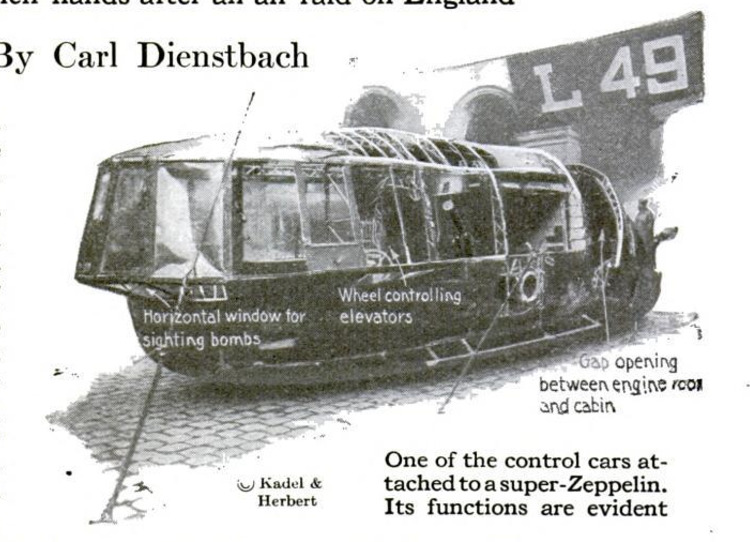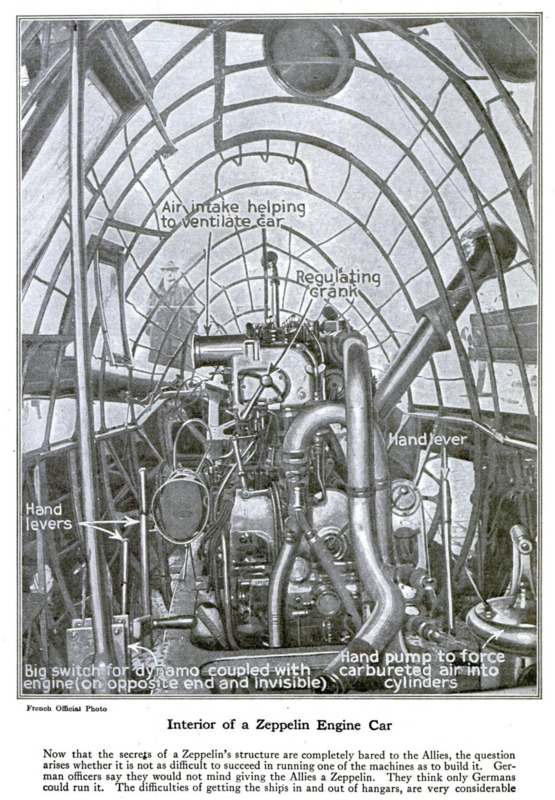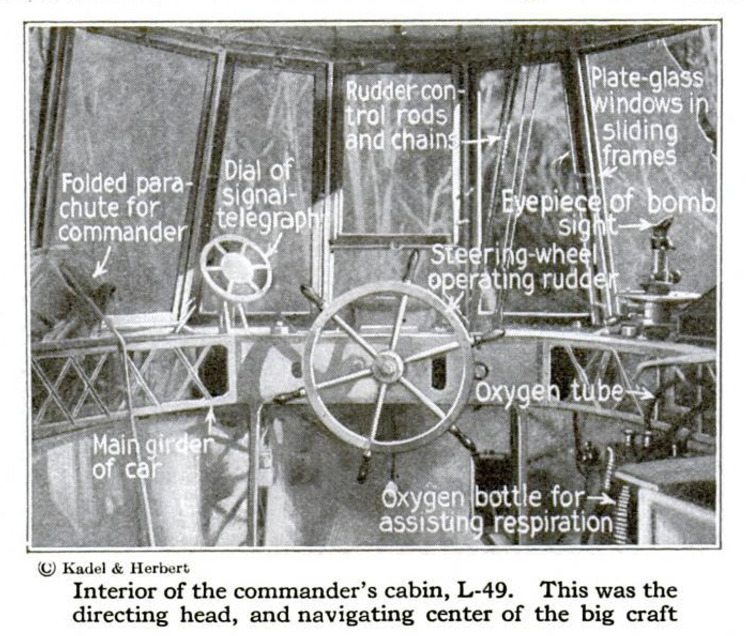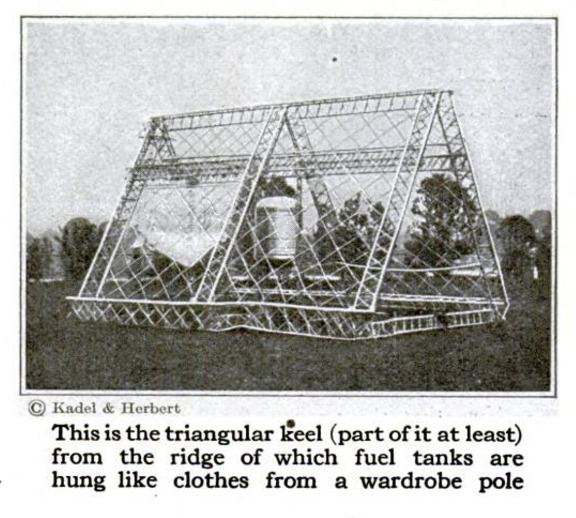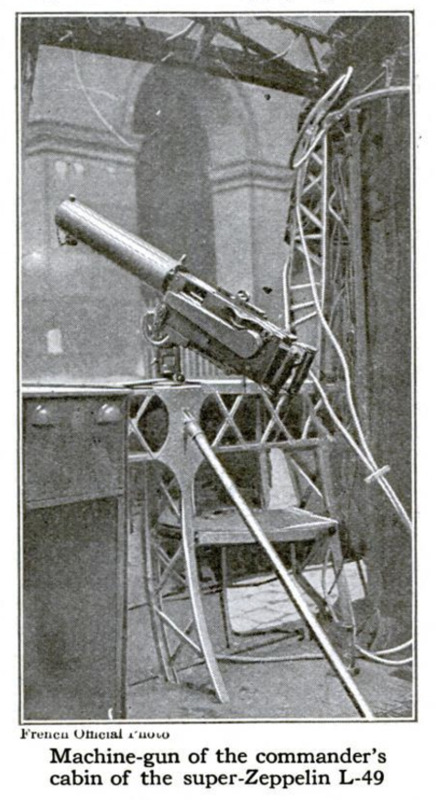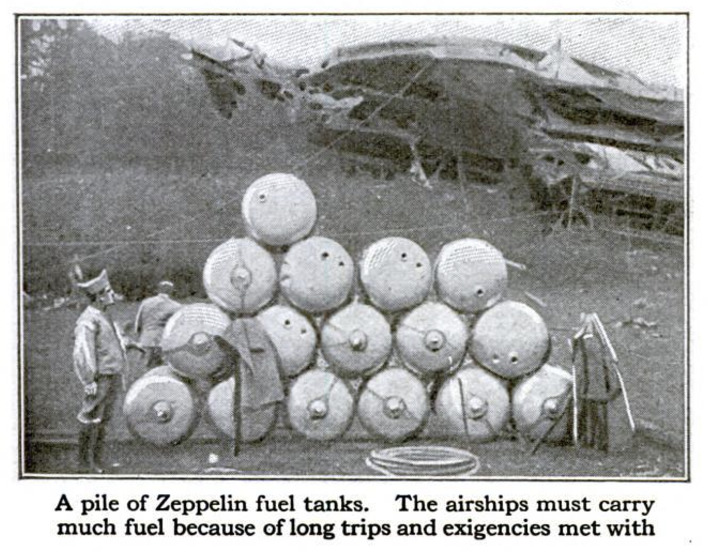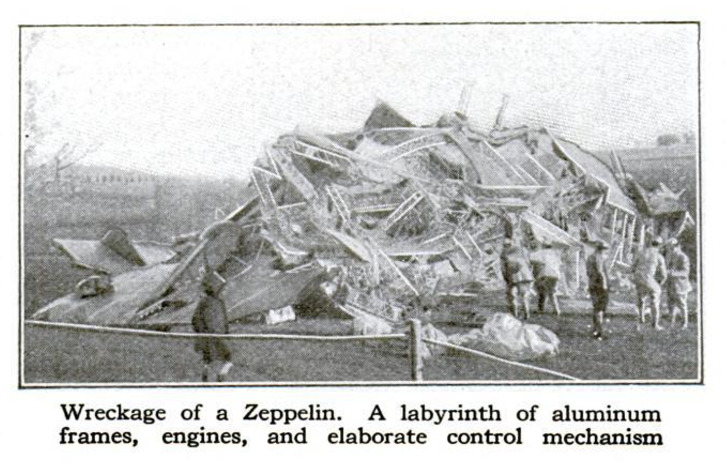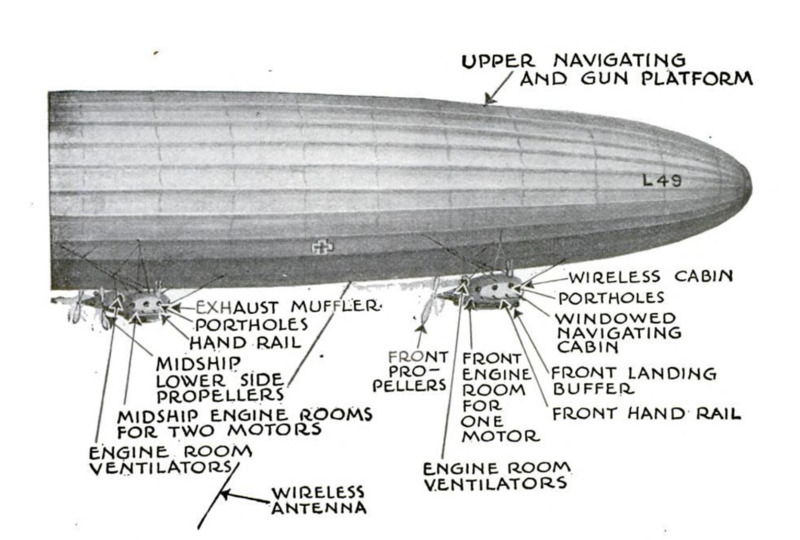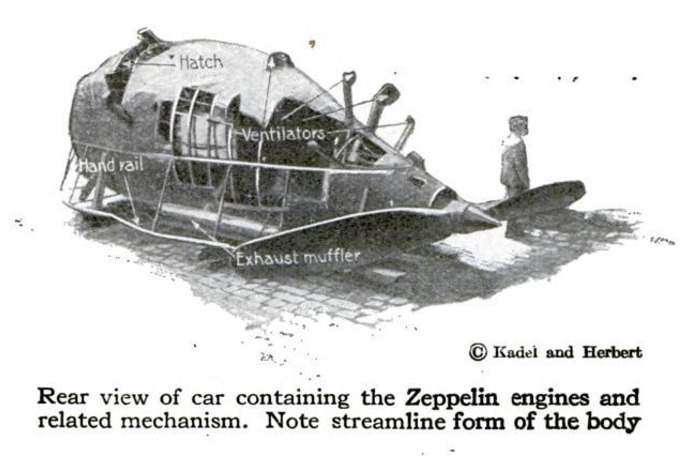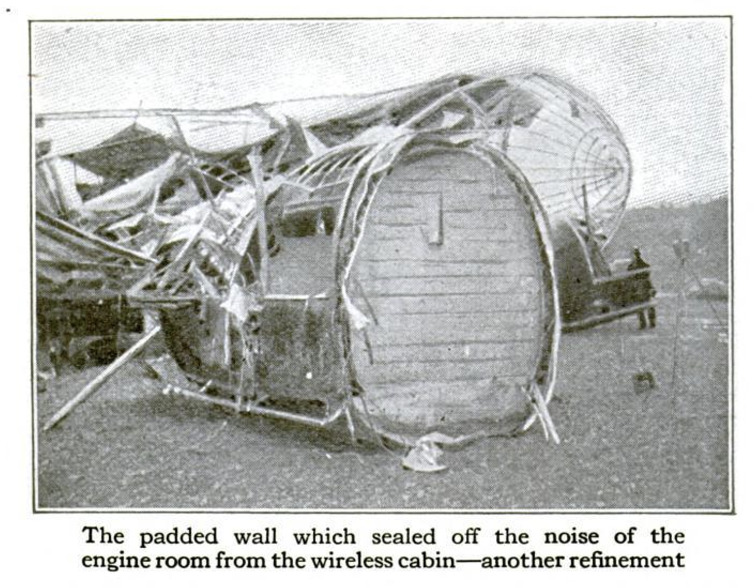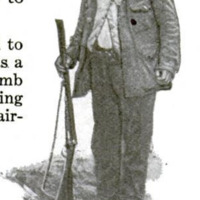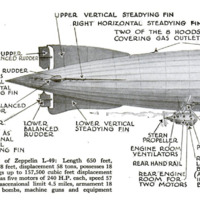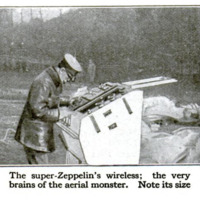-
Title (Dublin Core)
-
L-49 Zeppelin
-
Article Title and/or Image Caption (Dublin Core)
-
Baring the Super-Zeppelin's Secret. What the French found when they examined the L-49 which fell into their hands after an air raid on England
-
extracted text (Extract Text)
-
IT was the oddest sort of an
accident that preserved the
L-49 intact for French in-
spection. She was one of a
fleet of super-Zeppelins which
had successfully eluded the air-
planes and anti-aircraft guns of
Great Britain, only to come to
grief on French soil. She lost
her way. Her gasoline supply
exhausted, she was compelled
to descend in the heart of
France. True to his duty, her
captain attempted to destroy
her. He leveled the pistol
which was to fire into her great hydrogen-
filled envelope a flaming pellet; when he
heard a shout: |
“Hands up!”
He looked around and found himself |
gazing into the muzzle of a shotgun in the
hands of Jules Boiteux, who had been |
out hunting. The crew had retired to a
safe distance because of the conflagration
that would follow the ignition of the gas. |
There was nothing left for it but to yield.
And so a man with a shotgun captured |
one of Germany's latest super-
Zeppelin and placed in the
hands of the French Govern-
ment military information al-
most priceless.
How Fuel Was Sacrificed to
Carry Bombs
Why was the L-49 forced to
land? A super-Zeppelin has a
radius of action and a bomb
carrying capacity far exceeding
that of ‘any other type of air-
craft. The experiences
of the war have demon-
strated that the drop-
ping of a mere bomb or
two is a futile proceed-
ing. Literally tons of
explosives must rain
down from the sky to
justify the risks of a
bombing expedition. When airplanes
set out to raid German towns they
travel in scores—a fashion inaugurated by
the French. Only thus is it possible to
deliver a telling blow. Because of its
enormous carrying capacity, a super-
Zeppelin is in many respects a better
bombing apparatus than a flock of air-
planes. But the L-49 could not carry
tons of explosives from Oldenburg to Lon-
don without sacrificing some of her fuel-
carrying capacity. Her fuel load had to
be reduced to an unsafe mini-
be reduced to an unsafe mini-
mum.
This juggling of loads also
has its effect on the maneu-
vering power of a Zeppelin.
It has been pointed out more
than once in the pages of the
POPULAR SCIENCE MONTHLY
that a huge dirigible flies not
only as an airship but also as an
airplane. In other words, it is
buoyed up not only by its gas,
but also by the upward pres-
sure of the air against its enor-
mous surface. Indeed, were it
not for the pressure of the air
against its thousands of square
feet of exposed area—a pres-
~ sure comparable in every re-
spect with that which keeps an
airplane aloft—the giant rigid
dirigible would be an impos-
sibility. It is this air pressure which is
relied upon to control the craft when the
gas expands at great height and is dis-
gipated, or when it shrinks in volume in a
sibility. It is this air pressure which is
relied upon to control the craft when the
gas expands at great height and is dis-
gipated, or when it shrinks in volume in a
cold layer of
the atmo-
sphere, or
when tons of
weight are
added by
dew, rain,
snow orsleet.
Moreover,
descending
or ascending
currents of
air force the
ship up or
down, and
these cur-
rents must
be counter-
acted by fly-
ing the ship
airplane-
style.
All this means that much is expected
of the engines. The ship must be driven
through the air at high speed if the
most is to be made of the airplane
effect. Since so much depends on mere
motive power, the 1-49 had been reduced
to a huge cylinder of gas, a few cars for
the crew, an enormous load of bombs,
and the most powerful engines that air
can support.
Wireless Signals from Germany Guide
the Zeppelins
The passenger-carrying Zeppelins that
plied over the Rhine before the war, had
luxurious cabins. Fully three times as
bulky as these ante-bellum vessels, the
L-49 was nevertheless as bare of comforts
as a racing automobile. She had been
stripped of everything not absolutely
necessary. For instance, she had only
two machine guns; hence she was prac-
tically defenseless.
To the necessity of greatly reducing the
amount of fuel so that an enormous quan-
tity of bombs might be dropped on Eng-
land, may be attributed the capture of the
L-49 on French soil. Just how she lost
her way, it is needless to explain here;
the subject is discussed in the April
issue of the POPULAR SCIENCE MONTH-
LY. It may be stated in passing,
however, that Zeppelins are guided by
wireless signals sent from German sta-
tions. The
capture of
the L-49
may be at-
tributed
either to
those un-
explained
vagaries of
wireless
with which
every ama-
teur opera-
tor is famil-
iar, or to
ingenious
radio decep-
tion on the
part of the
English or
French. Of
a fog-bound
raiding squadron of a dozen or more
ships, two returned safely on their regu-
lar course; six lost their way, drifted tem-
porarily over France, luckily for them un-
observed, and succeeded in stemming a
frigid, violent northeasterly gale that had
sprung up enough to regain German terri-
tory. The rest succumbed to attack and
came to the end of their supplies in a gale
which they had had to buffet with a
limited amount of fuel. Rising to an
altitude of 16,000 feet to escape shells and
pursuing airplanes, they encountered an
upper wind so violent that they drifted
farther and farther into France in spite of
all their fuel-wasting efforts. One vessel
had been ignited in the air by an anti-
aireraft battery into the range of which it
had blundered. One
senselessly kept on flee-
ing until it was liter-
ally swallowed up by
the Mediterranean.
Two wisely landed and
surrendered. One of
them was the L-49
which was so oddly
prevented from hiding
its secret by self-de-
struction; the other
was reduced to a mere
mass of wreckage by
its commander. = A
fifth, of uncertain iden-
dity, is supposed to
have gained Switzer-
land (possibly Fried-
richshafen) in a dam-
aged condition.
An Immense, Naked
Hull of Perfect Form
The marvelous prog-
ress in design revealed
by the L-49 is apparent
to anyone who is at all
familiar with the evolu-
tion of the Zeppelin.
Her perfection lay in her simplicity.
Speed is the life and soul of a Zeppelin —
a speed that is never less than sixty miles
an hour and may be as much as one hun-
dred. Speed saves the Zeppelin from |
destruction in a gale. And speed has
been obtained by trebling the size and by
applying the lessoris learned in developing
the one-hundred-and-
thirty-mile-an-hour
fighting airplane.
In an airplane, it will
be remembered, wires
and struts are elimin-
ated wherever possible;
they offer too much
resistance to the wind.
The aviator is seated
in a beautifully mod-
eled boat-like body
which parts the air
with little disturbance,
thanks to its stream-
line form. The rud-
ders are as simple as
possible. All the les-
sons which the war has
taught the airplane de-
signer have borne fruit
in the L-49. There is
the same inclosing of
mechanical and struc-
tural parts, the same
streamlining every-
where, the same sim-
plification of rudders,
the same reduction of
surface and friction,
the same disregard of mere bulk, provided
it is correctly designed. As the drawing
shows, the L-49 is but a naked, immense
fish-shaped envelope of perfect stream-line
~ form, with single monoplane
fins and rudders, and with
absolutely no appendages
save four cars, each entirely
enclosed and each torpedo-
shaped. Only a rigid hull
permits such ultra-refinement
of form. Here we have an-
other parallel with the de-
velopment of the airplane.
As the number and rigidity of
the ribs in an airplane was
increased, so all types of
dirigibles have ceded their
place to the Zeppelin despite
opposition—all for perfectly
good and practical reasons.
The smooth, clean sweep of
the craft was broken on the
sides and at the rear car only by the
mountings and shafts of two propellers—
a strictly necessary evil because two of the
propellers must run when the cars rest on
the ground and because the others behind
the cars cannot revolve.
In the old Zeppelins there was a tri-
angular keel under the hull. The L-i9
has that keel too; but it has been in-
verted like a glove so that now it protrudes
into the interior with the apex of the
triangle uppermost. It stiffens the en-
velope—its function from the very be-
ginning; but two-thirds of its air friction
is eliminated by this ingenious tucking
away of its larger sides. Why were not
the cars and engines moved into the
envelope as
well? There
was no neces-
sity for that.
Modern sci
ence teaches
that a stream-
lined bulk af-
fords no more
wind resist-
ance than
slender ir-
regular ap-
pendages.
The cars were
given the
shapes of torpedoes. Hence they offered
no serious impediment to speed and dis-
pensed with the weight of special appa-
ratus for insulation and ventilation that
would be needed for engine rooms inside
the gas-inflated hull.
Small as the cars are, the space allotted
for the crew is not “as restricted as in a
submarine,” as the French put it. There
is an abundance of room in a wide passage-
way within the immense hull. But there
is not as much comfort as may be sup-
posed. These ample cabins serve merely
as a shelter from the icy gale that beats
against the outside of the ship. They are
about as comfortable as the clouds of
heaven are for the angels pictured in
children’s
books. Being
pitched about
at sea is noth-
ing compared
with a refrac-
tory Zeppelin
airship.
A Zeppelin
is at once the
flimsiest and
the staunch-
est of artificial
structures.
‘When the old
Zeppelin was
trebled in size the weight could not be
disproportionately increased.
“A Gigantic Piece of Lacework,”
said the French
The framework of the huge hull in
which the gas bags are confined has been
multiplied in parts and reduced in ma-
terial to a veritable cloud of riveted
lattice-work made of channeled strips of
the thinnest
aluminum
sheeting. In-
deed, the frame
of the L-49 has
been described
by the French
as a “gigantic
piece of lace-
work."
This frame
serves exactly
the same pur-
pose as the
pole in your
‘wardrobe, from
which you suspend coats on hangers. As
a whole, the frame could resist the fiercest .
gale, and yet it could not support a single
man’s weight on one of its component
parts! If ever there was a scientifically
designed structure, it is this framework of
the L-49. It is applied science with a
vengeance! From a long row of correctly
placed hooks, hang all the aluminum fuel
tanks, the water ballast tanks and lastly,
all the bombs—just as the clothes in your
closet are suspended from the pole on their
hangers. The fuel tanks are dropped
through trap doors on guides like ballast.
The bombs fall similarly; but they are
electrically released, since the one-hun-
dredth part of a second is vital in hitting a
target and hu-
man agency is
too slow. |
The Gloomy
Boardwalk
Within the
framework is
a long passage-
way for the
crew—a mere
boardwalk,
nine inches
wide, com-
posed of
wooden slats
separated one from the other by several
inches. Along this passageway hangs a
series of hammocks or cots. The crew
almost “sleeps on a clothes line.” Real
comfort was merely a subject for pleas-
ant dreams, for life in that passageway
must have resembled that of a tight-
rope walker who dines and sleeps in pre-
tended comfort on his lofty perch. Air-
ships can roll and pitch like any steamer
on the bounding deep, and so a hand-
railing in the shape of a wire cable is
provided on one side of this board-
walk. If a man stumbles he is caught by
a wide netting of rope cord, “the thick-
mess of a pencil” as the French said—a
netting placed, not to save his neck, but
to stiffen the cloth covering of the hull
against the gale. It is doubtful if that
thin netting would save him from the
abyss below. I traveled in the passenger
Zeppelin “Viktoria Luise” before the war.
1 understand now why I ‘was warned that
“passengers are not permitted outside the
cabin,” by an officer who saw me peeping
through the door that led into the pas-
sageway. At night a man is guided along
this perilous board-
walk not by elec-
tric lights (they
would betray the
presence of theship
to an anti-aircraft
battery below),
but by ghostly
patches of lumin-
ous paint. Even
in daytime the
place must be
weird and gloomy,
because the ship's
whole belly is
painted coal black
to make it invisi-
ble at night. The upper
surface of the hull is painted |
white and gray to blend
with the clouds as seen
from an airplane. |
Other details of the L-49, |
the dimensions, the power,
the number of engines and
propellers and their ar- |
rangement only corroborate
what has been quite cor-
rectly described in previous
articles on Zeppelins, pub-
lished in the POPULAR ScI- |
ENCE MONTHLY. The only |
‘important progress made
consists in torpedo-shaping
and stream-lining all the |
cars. |
Although life on a super-
Zeppelin is not exactly luxurious, some
comforts at least are provided. The pro-
tection against the biting wind is perfect.
The powerful dynamos which supply the
radio apparatus also furnish current for
electric heating.
The material of the gas bags is cotton-
lined goldbeaters’ skin. To me the chief
advantage of such a fabric lies in the fact
that it remains gas-tight in the flabby,
even crumpled condition that the gas bags
50 often must assume when they return to
a low altitude after they have been in-
ordinately expanded by a flight at 10,000
feet and more.
This, then, isbriefly the kind of machine
a Zeppelin is. Germany's well-guarded
secret is in the hands of the Allies at last,
and they will no doubt make good use of
it. They already have a good number of
air-craft of their
own, but pointers
are always wel
come, even from
the enemy. If
there is anything
new or advanta-
geous about this
enemy machine
the Allied engi-
neers may be de-
pended upon to
utilize it to its full
value, for Germany
has not a monop-
olyof all the brains
and ingenuity.
-
Contributor (Dublin Core)
-
Kadel & Herbert (photos)
-
Language (Dublin Core)
-
eng
-
Date Issued (Dublin Core)
-
1918-03
-
pages (Bibliographic Ontology)
-
372-378
-
Rights (Dublin Core)
-
Public Domain (Google digitized)
-
Archived by (Dublin Core)
-
Filippo Valle
-
Alberto Bordignon (Supervisor)
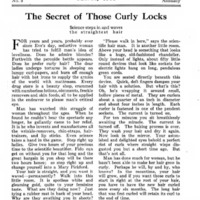 Popular Science Monthly, v. 92, n. 3, 1918
Popular Science Monthly, v. 92, n. 3, 1918


